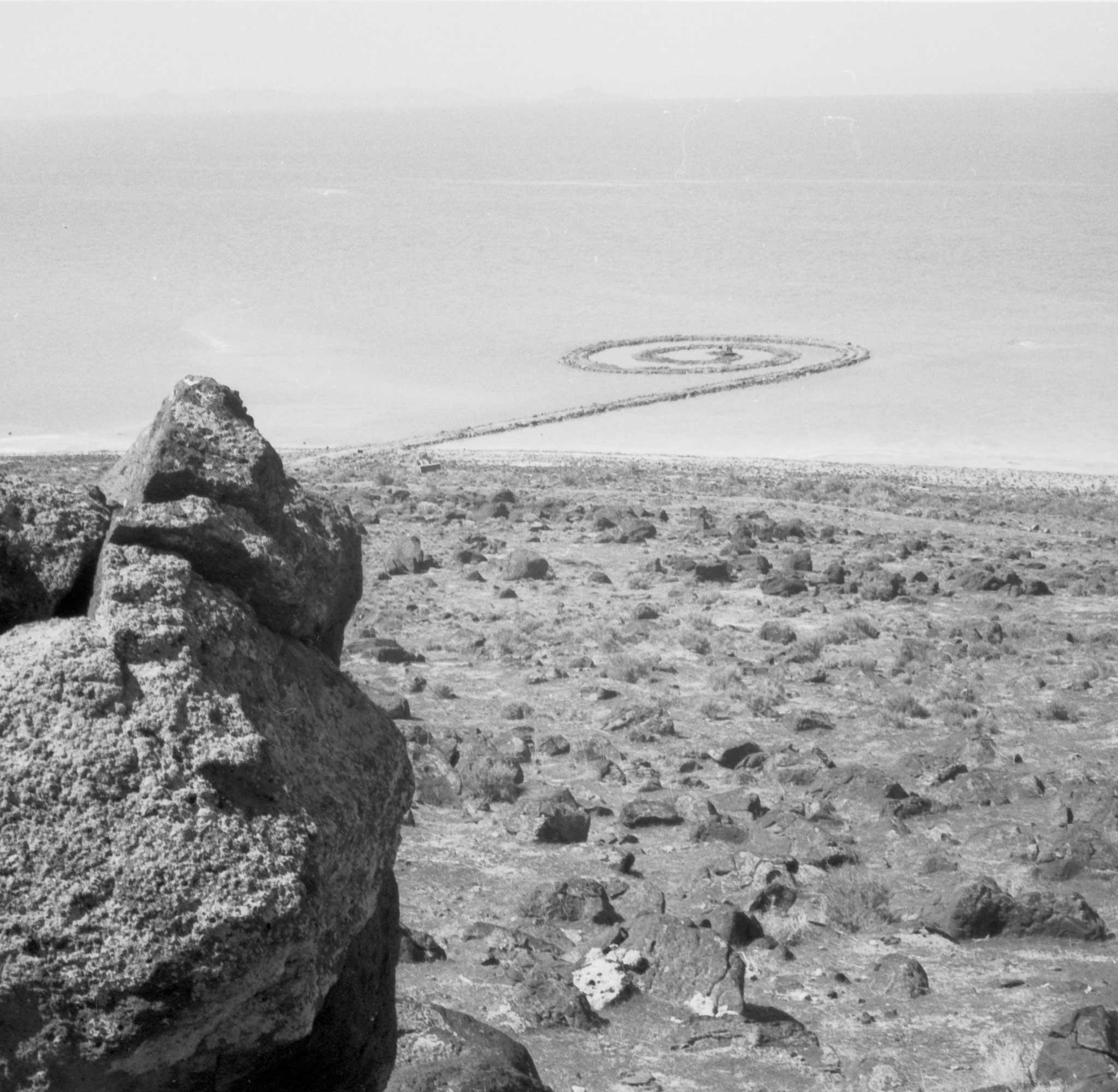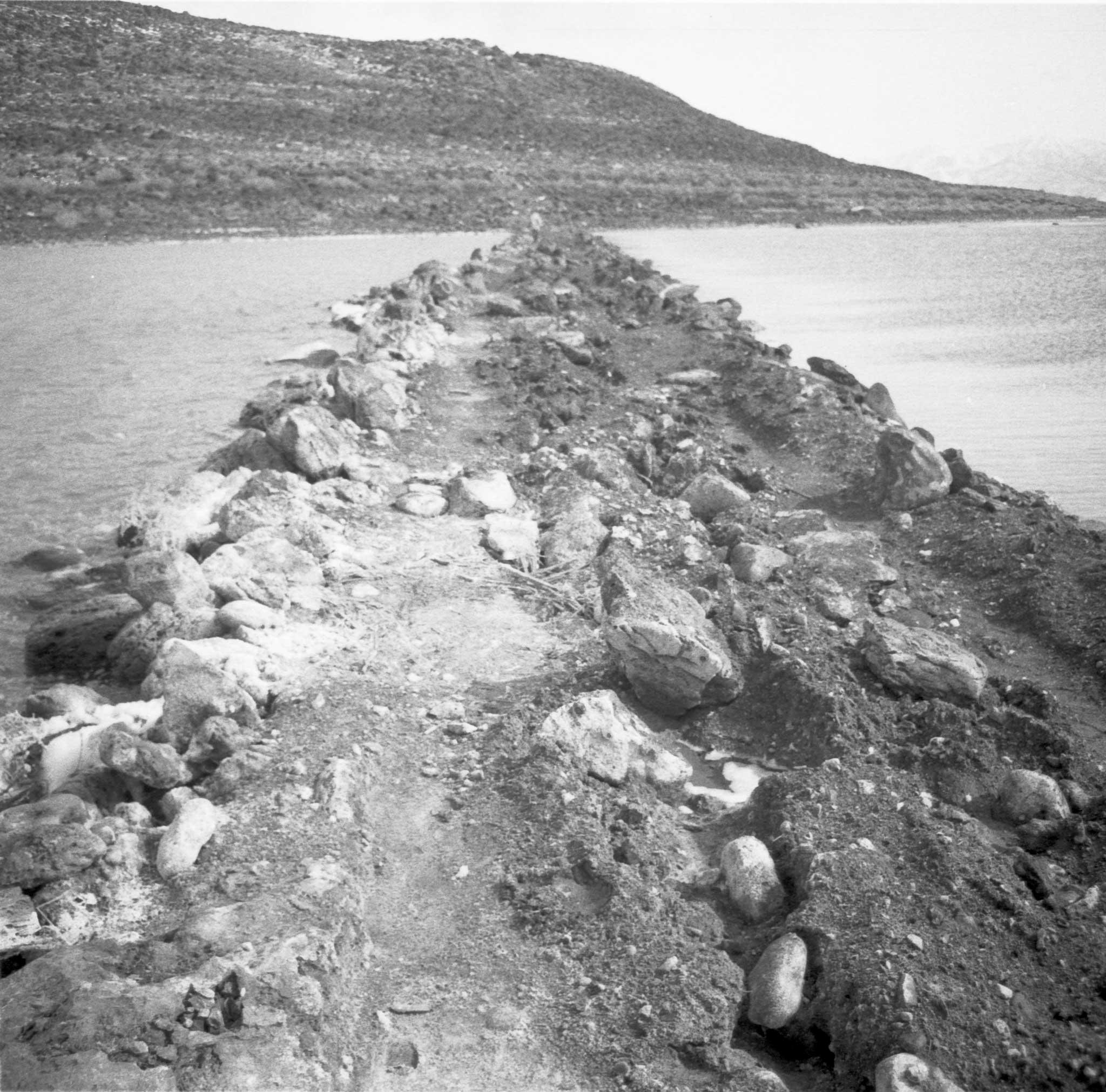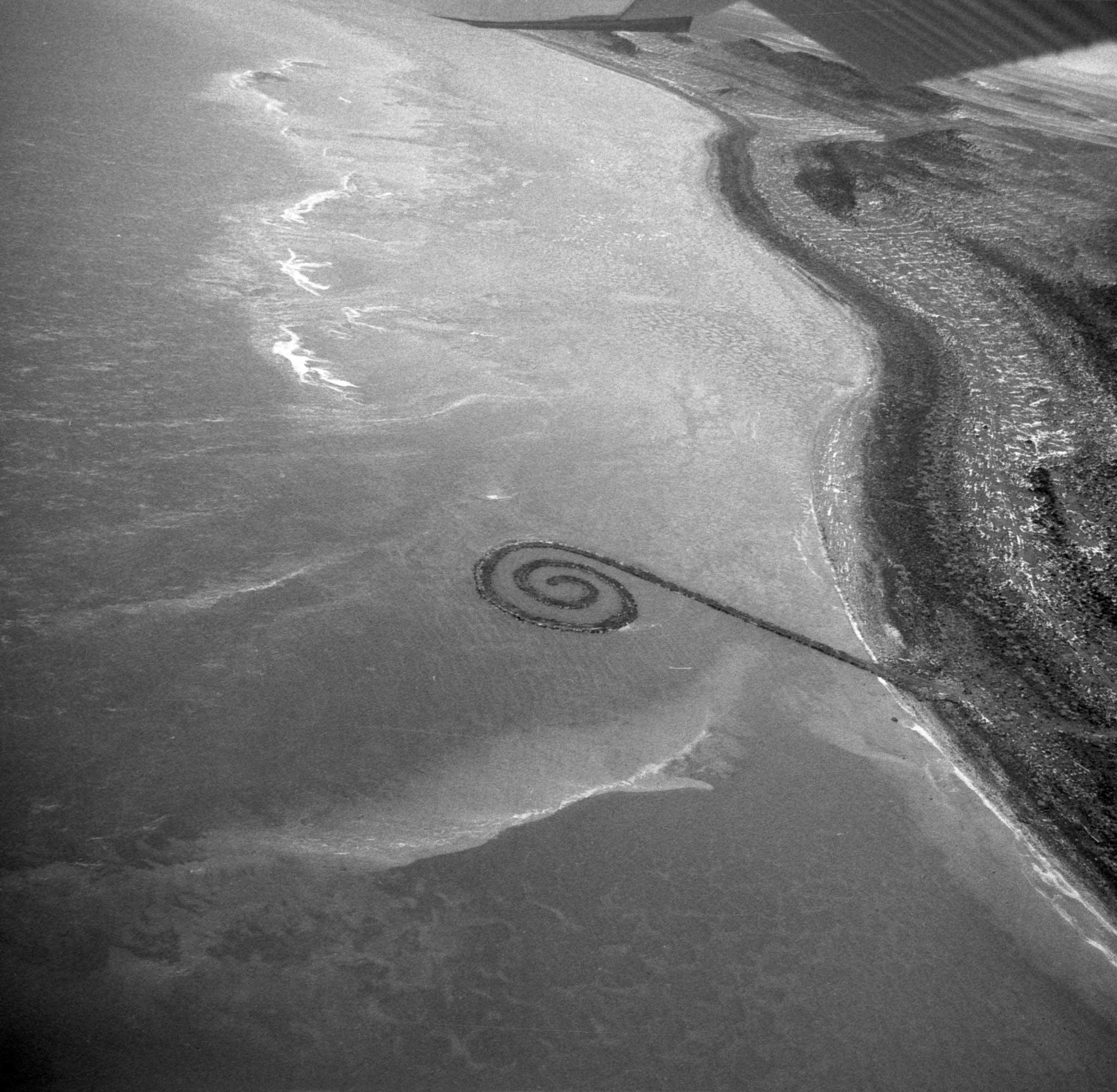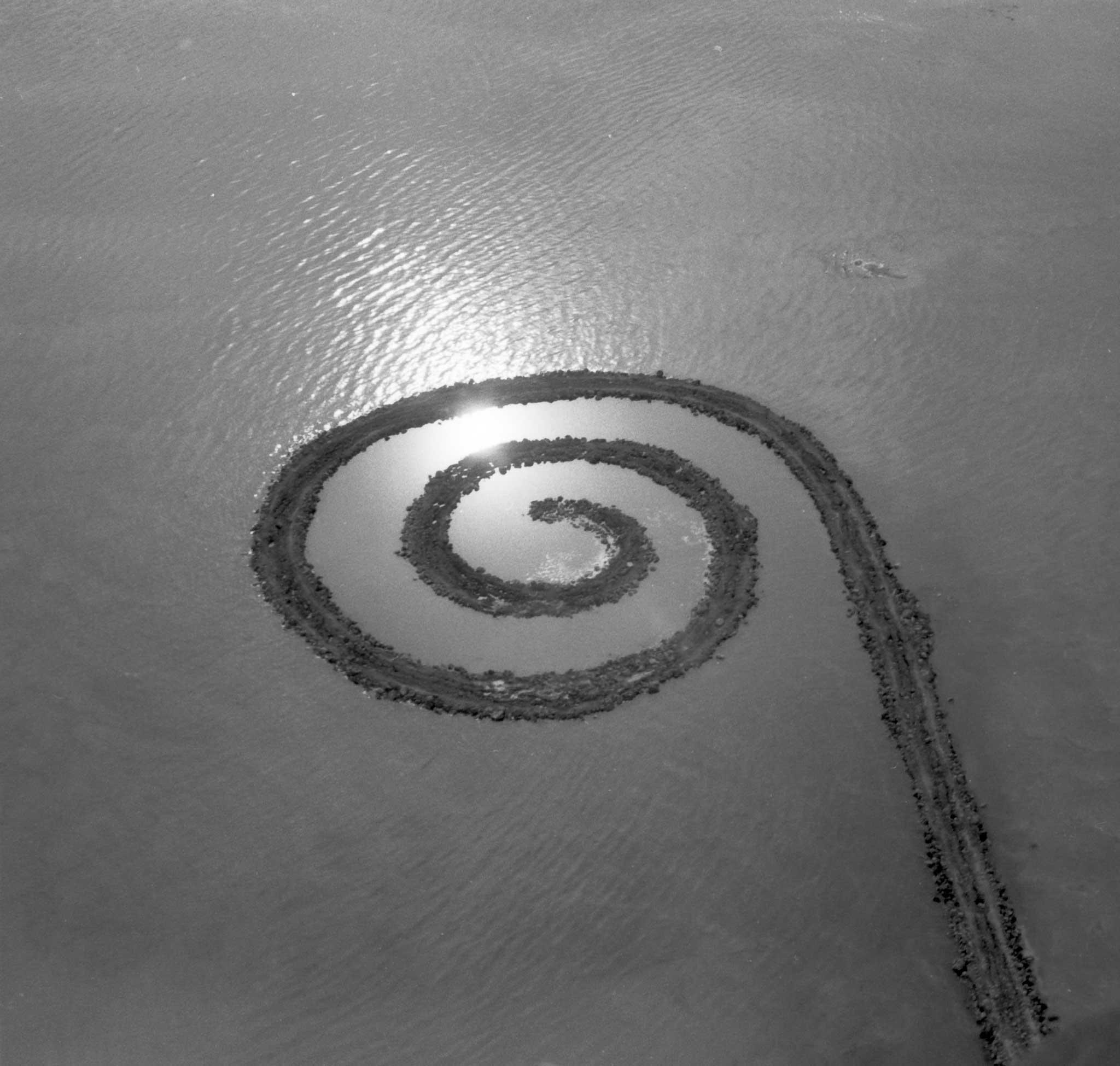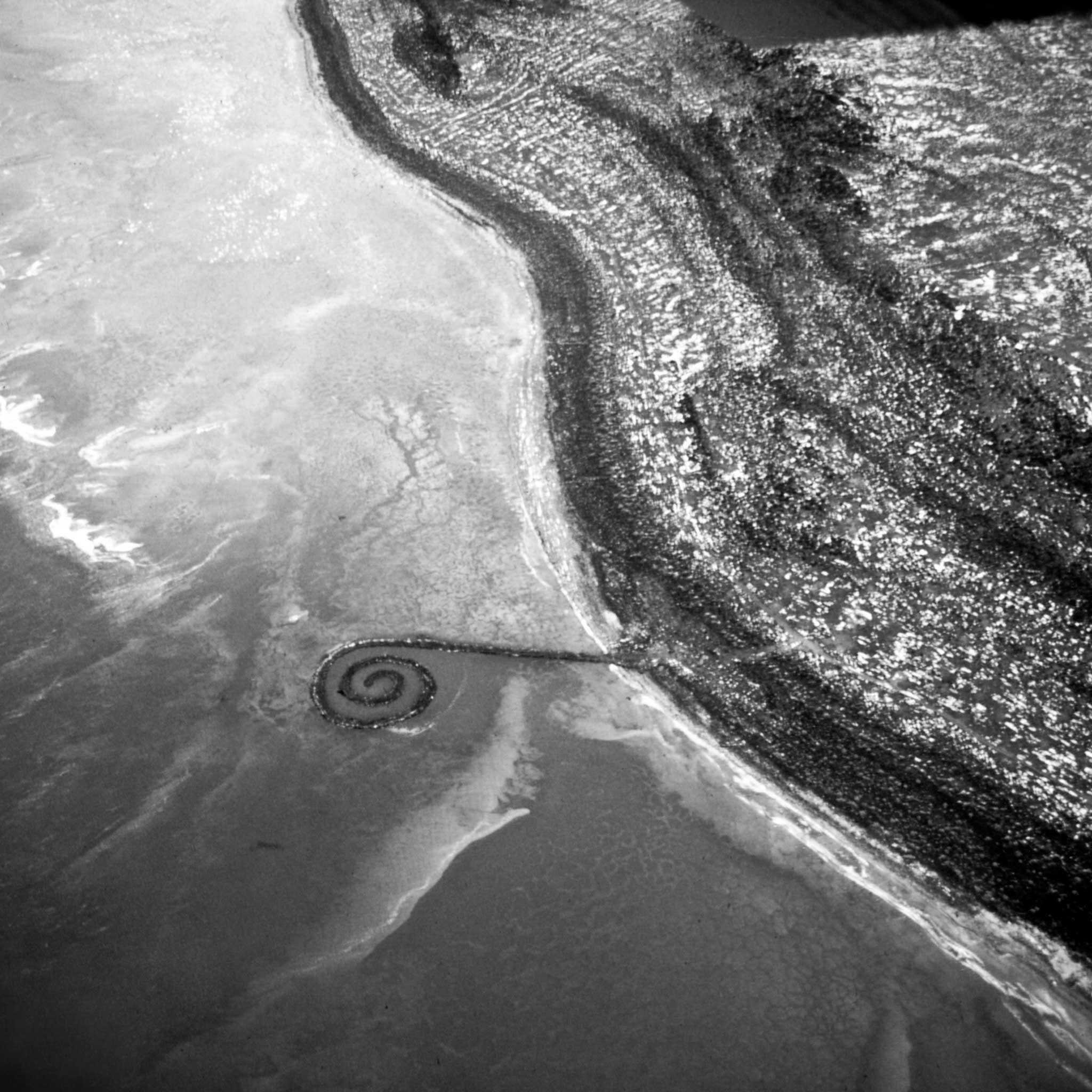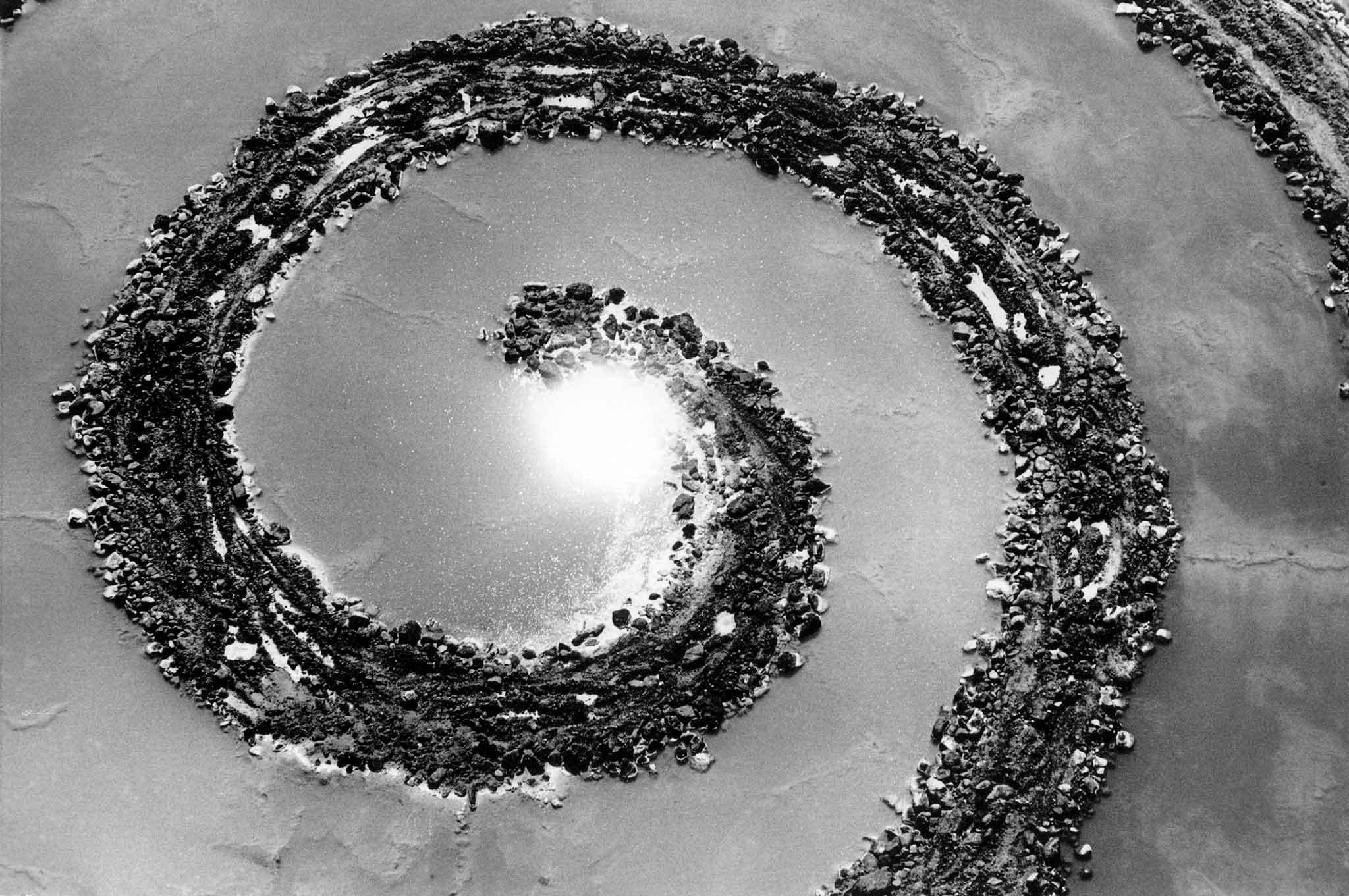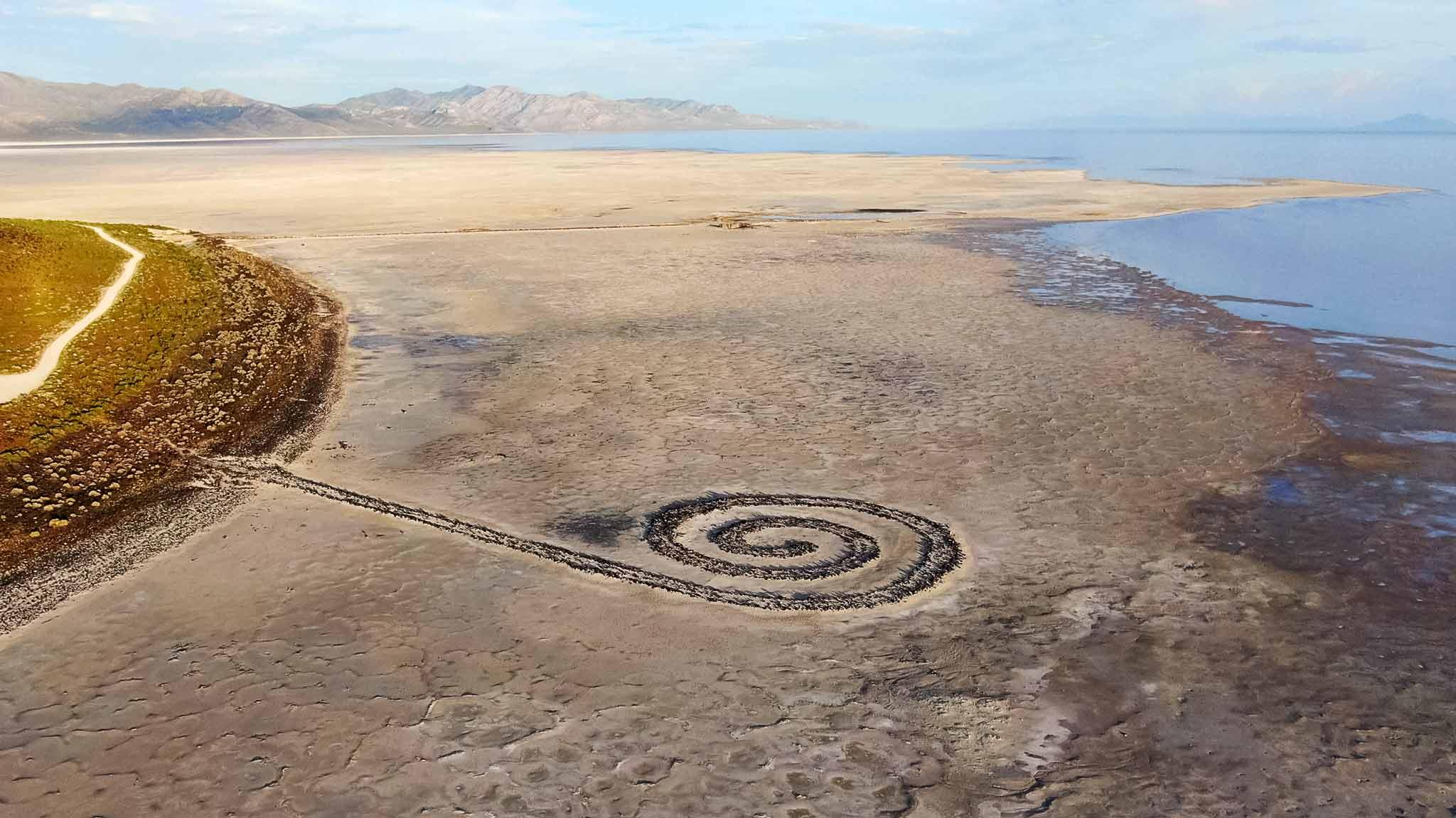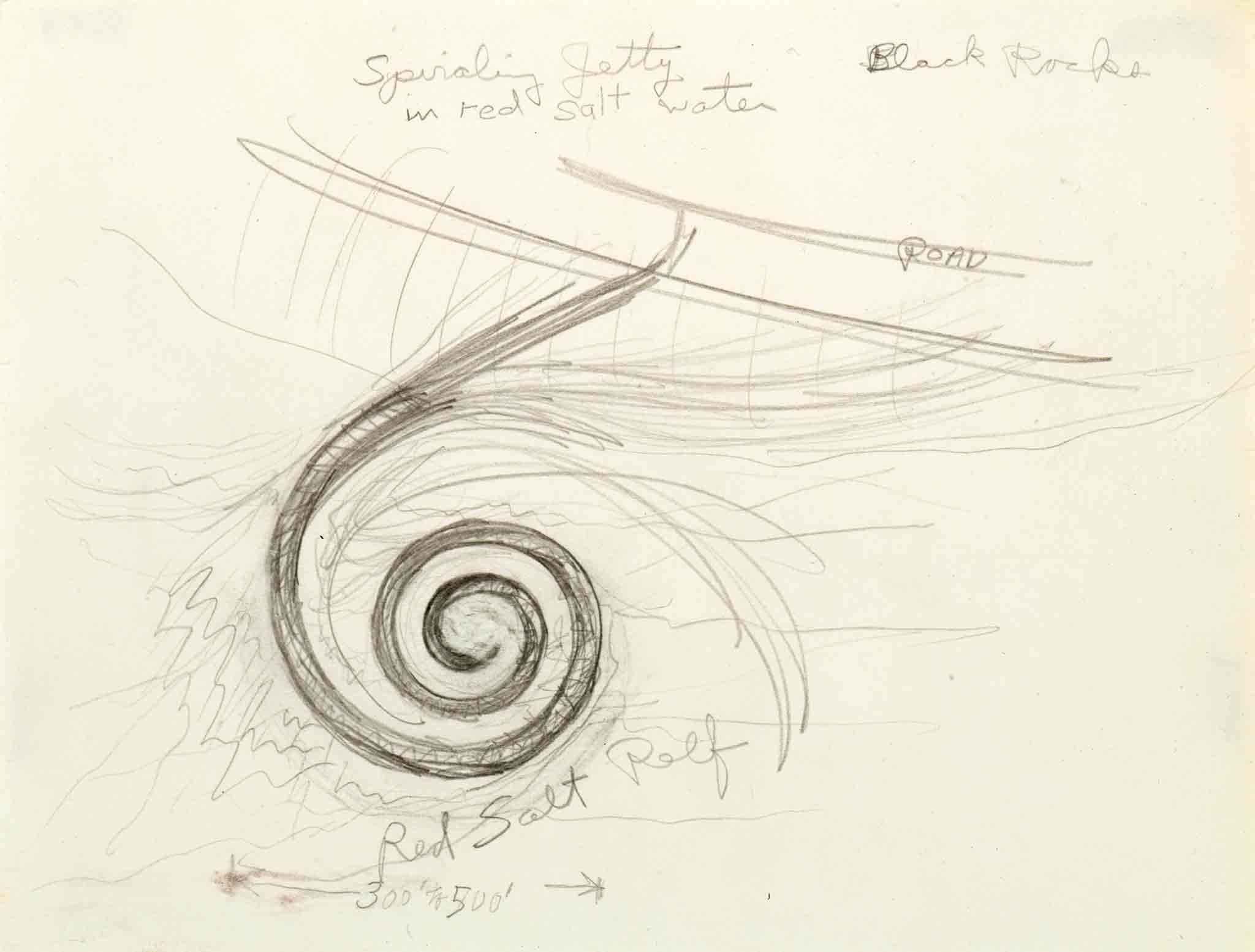The Spiral Jetty
Red is the most joyful and dreadful thing in the physical universe, it is the fiercest note, it is the highest light, it is the place where the walls of this world of ours wear the thinnest and something beyond burns through.
—G.K. Chesterton
My concern with salt lakes began with my work in 1968 on the Mono Lake Site-Nonsite in California.1 Later I read a book called Vanishing Trails of Atacama by William Rudolph which described salt lakes (salars) in Bolivia in all stages of desiccation and filled with micro bacteria that give the water surface a red color. The pink flamingos that live around the salars match the color of the water. In The Useless Land, John Aarons and Claudio Vita-Finzi describe Laguna Colorada: “The basalt (at the shores) is black, the volcanos purple, and their exposed interiors yellow and red. The beach is grey and the lake pink, topped with the icing of iceberg-like masses of salts.”2 Because of the remoteness of Bolivia and because Mono Lake lacked a reddish color, I decided to investigate the Great Salt Lake in Utah.
From New York City I called the Utah Park Development and spoke to Ted Tuttle, who told me that water in the Great Salt Lake north of Lucin Cutoff, which cuts the lake in two, was the color of tomato soup. That was enough of a reason to go out there and have a look. Tuttle told my wife, Nancy Holt, and myself of some people who knew the lake. First we visited Bill Holt who lived in Syracuse. He was instrumental in building a causeway that connected Syracuse with Antelope Island in the southern part of the Great Salt Lake. Although that site was interesting, the water lacked the red coloration I was looking for, so we continued our search. Next we went to see John Silver on Silver Sands Beach near Magna. His sons showed us the only boat that sailed the lake. Due to the high salt content of the water it was impractical for ordinary boats to use the lake, and no large boats at all could go beyond the Lucin Cutoff on which the transcontinental railroad crossed the lake. At that point I was still not sure what shape my work of art would take. I thought of making an island with the help of boats and barges, but in the end I would let the site determine what I would build. We visited Charles Stoddard, who supposedly had the only barge on the north side of the cutoff. Stoddard, a well-driller, was one of the last homesteaders in Utah. His attempt to develop Carrington Island in 1932 ended in failure because he could not find fresh water. “I’ve had the lake,” he said. Yet, while he was living on the island with his family he made many valuable observations of the lake. He was kind enough to take us to Little Valley on the east side of the Lucin Cutoff to look for his barge—it had sunk. The abandoned man-made harbors of Little Valley gave me my first view of the wine-red water, but there were too many “Keep Out” signs around to make that a practical site for anything, and we were told to “stay away” by two angry ranchers. After fixing a gashed gas tank, we returned to Charles Stoddard’s house north of Syracuse on the edge of some salt marshes. He showed us photographs he had taken of “icebergs,”3 and of Kit Carson’s cross carved on a rock on Fremont Island. We then decided to leave and go to Rozel Point.
Driving west on Highway 83 late in the afternoon, we passed through Corinne, then went on to Promontory. Just beyond the Golden Spike Monument, which commemorates the meeting of the rails of the first transcontinental railroad, we went down a dirt road in a wide valley. As we traveled, the valley spread into an uncanny immensity unlike the other landscapes we had seen. The roads on the map became a net of dashes, while in the far distance the Salt Lake existed as an interrupted silver band. Hills took on the appearance of melting solids, and glowed under amber light. We followed roads that glided away into dead ends. Sandy slopes turned into viscous masses of perception. Slowly, we drew near to the lake, which resembled an impassive faint violet sheet held captive in a stoney matrix, upon which the sun poured down its crushing light. An expanse of salt flats bordered the lake, and caught in its sediments were countless bits of wreckage. Old piers were left high and dry. The mere sight of the trapped fragments of junk and waste transported one into a world of modern prehistory. The products of a Devonian industry, the remains of a Silurian technology, all the machines of the Upper Carboniferous Period were lost in those expansive deposits of sand and mud.
Two dilapidated shacks looked over a tired group of oil rigs. A series of seeps of heavy black oil more like asphalt occur just south of Rozel Point. For forty or more years people have tried to get oil out of this natural tar pool. Pumps coated with black stickiness rusted in the corrosive salt air. A hut mounted on pilings could have been the habitation of “the missing link.” A great pleasure arose from seeing all those incoherent structures. This site gave evidence of a succession of man-made systems mired in abandoned hopes.
About one mile north of the oil seeps I selected my site. Irregular beds of limestone dip gently eastward, massive deposits of black basalt are broken over the peninsula, giving the region a shattered appearance. It is one of the few places on the lake where the water comes right up to the mainland. Under shallow pinkish water is a network of mud cracks supporting the jig-saw puzzle that composes the salt flats. As I looked at the site, it reverberated out of the horizons only to suggest an immobile cyclone while flickering light made the entire landscape appear to quake. A dormant earthquake spread into the fluttering stillness, into a spinning sensation without movement. This site was a rotary that enclosed itself in an immense roundness. From that gyrating space emerged the possibility of the Spiral Jetty. No ideas, no concepts, no systems, no structures, no abstractions could hold themselves together in the actuality of that evidence. My dialectics of site and nonsite whirled into an indeterminate state, where solid and liquid lost themselves in each other. It was as if the mainland oscillated with waves and pulsations, and the lake remained rock still. The shore of the lake became the edge of the sun, a boiling curve, an explosion rising into a fiery prominence. Matter collapsing into the lake mirrored in the shape of a spiral. No sense wondering about classifications and categories, there were none.
After securing a twenty year lease on the meandering zone,4 and finding a contractor in Ogden, I began building the jetty in April, 1970. Bob Phillips, the foreman, sent two dump trucks, a tractor, and a large front loader out to the site. The tail of the spiral began as a diagonal line of stakes that extended into the meandering zone. A string was then extended from a central stake in order to get the coils of the spiral. From the end of the diagonal to the center of the spiral, three curves coiled to the left. Basalt and earth were scooped up from the beach at the beginning of the jetty by the front loader, then deposited in the trucks, where upon the trucks backed up to the outline of stakes and dumped the material. On the edge of the water, at the beginning of the tail, the wheels of the trucks sank into a quagmire of sticky gumbo mud. A whole afternoon was spent filling in this spot. Once the trucks passed that problem, there was always the chance that the salt crust resting on the mud flats would break through. The Spiral Jetty was staked out in such a way as to avoid the soft muds that broke up through the salt crust; nevertheless there were some mud fissures that could not be avoided. One could only hope that tension would hold the entire jetty together, and it did. A cameraman was sent by the Ace Gallery in Los Angeles to film the process.
The scale of the Spiral Jetty tends to fluctuate depending on where the viewer happens to be. Size determines an object, but scale determines art. A crack in the wall if viewed in terms of scale, not size, could be called the Grand Canyon. A room could be made to take on the immensity of the solar system. Scale depends on one’s capacity to be conscious of the actualities of perception. When one refuses to release scale from size, one is left with an object or language that appears to be certain. For me scale operates by uncertainty. To be in the scale of the Spiral Jetty is to be out of it. On eye level, the tail leads one into an undifferentiated state of matter. One’s downward gaze pitches from side to side, picking out random depositions of salt crystals on the inner and outer edges, while the entire mass echoes the irregular horizons. And each cubic salt crystal echoes the Spiral Jetty in terms of the crystal’s molecular lattice. Growth in a crystal advances around a dislocation point, in the manner of a screw. The Spiral Jetty could be considered one layer within a spiraling crystal lattice, magnified trillions of times.
This description echoes and reflects Brancusi’s sketch of James Joyce as a “spiral ear” because it suggests both a visual and an aural scale, in other words it indicates a sense of scale that resonates in the eye and the ear at the same time. Here is a reinforcement and prolongation of spirals that reverberates up and down space and time. So it is that one ceases to consider art in terms of an “object.” The fluctuating resonances reject “objective criticism,” because that would stifle the generative power of both visual and auditory scale. Not to say that one resorts to “subjective concepts,” but rather that one apprehends what is around one’s eyes and ears, no matter how unstable or fugitive. One seizes the spiral, and the spiral becomes a seizure.
After a point, measurable steps (“Scale skal n. it. Or L; it. Scala; L scala usually scalae pl., I.a. originally a ladder; a flight of stairs; hence, b. a means of ascent”)5 descend from logic to the “surd state.” The rationality of a grid on a map sinks into what it is supposed to define. Logical purity suddenly finds itself in a bog, and welcomes the unexpected event. The “curved” reality of sense perception operates in and out of the “straight” abstractions of the mind. The flowing mass of rock and earth of the Spiral Jetty could be trapped by a grid of segments, but the segments would exist only in the mind or on paper. Of course, it is also possible to translate the mental spiral into a three-dimensional succession of measured lengths that would involve areas, volumes, masses, moments, pressures, forces, stresses, and strains; but in the Spiral Jetty the surd takes over and leads one into a world that cannot be expressed by number or rationality. Ambiguities are admitted rather than rejected, contradictions are increased rather than decrease – the alogos undermines the logos. Purity is put in jeopardy. I took my chances on a perilous path, along which my steps zigzagged, resembling a spiral lightning bolt. “We have found a strange footprint on the shores of the unknown. We have devised profound theories, one after another, to account for its origin. At last, we have succeeded in constructing the creature that made the footprint. And lo! It is our own”.6 For my film (a film is a spiral made up of frames) I would have myself filmed from a helicopter (from the Greek helix, helikos meaning spiral) directly overhead in order to get the scale in terms of erratic steps.
Chemically speaking, our blood is analogous in composition to the primordial seas. Following the spiral steps we return to our origins, back to the same pulpy protoplasm, a floating eye adrift in an antediluvian ocean. On the slopes of Rozel Point I closed my eyes, and the sun burned crimson through the lids. I opened them and the Great Salt Lake was bleeding scarlet streaks. My sight was saturated by the color of red algae circulating in the heart of the lake, pumping into ruby currents, no they were veins and arteries sucking up the obscure sediments. My eyes became combustion chambers churning orbs of blood blazing by the light of the sun. All was enveloped in a flaming chromosphere; I thought of Jackson Pollock’s Eyes in the Heat (1946; Peggy Guggenheim Collection). Swirling within the incandescence of solar energy were sprays of blood. My movie would end in sunstroke. Perception was heaving, the stomach turning, I was on a geologic fault that groaned within me. Between heat lightning and heat exhaustion the spiral curled into vaporization. I had the red heaves, while the sun vomited its corpuscular radiations. Rays of glare hit my eyes with the frequency of a Geiger counter. Surely, the storm clouds massing would turn into a rain of blood. Once, when I was flying over the lake, its surface seemed to hold all the properties of an unbroken field of raw meat with gristle (foam); no doubt it was due to some freak wind action. Eyesight is often slaughtered by the other sense, and when that happens it becomes necessary to seek out dispassionate abstractions. The dizzying spiral yearns for the assurance of geometry. One wants to retreat into the cool rooms of reason. But no, there was Van Gogh with his easel on some sun-baked lagoon painting ferns of the Carboniferous Period. Then the mirage faded into the burning atmosphere.
From the center of the Spiral Jetty
North — Mud, salt crystals, rocks, water
North by East — Mud, salt crystals, rocks, water
Northeast by North — Mud, salt crystals, rocks, water
Northeast by East — Mud, salt crystals, rocks, water
East by North — Mud, salt crystals, rocks, water
East — Mud, salt crystals, rocks, water
East by South — Mud, salt crystals, rocks, water
Southeast by East — Mud, salt crystals, rocks, water
Southeast by South — Mud, salt crystals, rocks, water
South by East — Mud, salt crystals, rocks, water
South — Mud, salt crystals, rocks, water
South by West — Mud, salt crystals, rocks, water
Southwest by South — Mud, salt crystals, rocks, water
Southwest by West — Mud, salt crystals, rocks, water
West by South — Mud, salt crystals, rocks, water
West — Mud, salt crystals, rocks, water
West by North — Mud, salt crystals, rocks, water
Northwest by West — Mud, salt crystals, rocks, water
Northwest by North — Mud, salt crystals, rocks, water
North by West — Mud, salt crystals, rocks, water
The helicopter maneuvered the sun’s reflection through the Spiral Jetty until it reached the center. The water functioned as a vast thermal mirror. From that position the flaming reflection suggested the ion source of a cyclotron that extended into a spiral of collapsed matter. All sense of energy acceleration expired into a rippling stillness of reflected heat. A withering light swallowed the rocky particles of the spiral, as the helicopter gained altitude. All existence seemed tentative and stagnant. The sound of the helicopter motor became a primal groan echoing into tenuous aerial views. Was I but a shadow in a plastic bubble hovering in a place outside mind and body? Et in Utah ego. I was slipping out of myself again, dissolving into a unicellular beginning, trying to locate the nucleus at the end of the spiral. All that blood stirring makes one aware of protoplasmic solutions, the essential matter between the formed and the unformed, masses of cells consisting largely of water, proteins, lipoids, carbohydrates, and inorganic salts. Each drop that splashed onto the Spiral Jetty coagulated into a crystal. Undulating waters spread millions upon millions of crystals over the basalt.
The preceding paragraphs refer to a “scale of centers” that could be disentangled as follows:
(a) ion source in cyclotron
(b) a nucleus
(c) dislocation point
(d) a wooden stake in the mud
(e) axis of helicopter propeller
(f) James Joyce’s ear channel
(g) the Sun
(h) a hole in the film reel.
Spinning off of this uncertain scale of centers would be an equally uncertain “scale of edges”:
(a) particles
(b) protoplasmic solutions
(c) dizziness
(d) ripples
(e) flashes of light
(f) sections
(g) foot steps
(h) pink water.
The equation of my language remains unstable, a shifting set of coordinates, an arrangement of variables spilling into surds. My equation is as clear as mud—a muddy spiral.
Back in New York, the urban desert, I contacted Bob Fiore and Barbara Jarvis and asked them to help me put my movie together. The movie began as a set of disconnections, a bramble of stabilized fragments taken from things obscure and fluid, ingredients trapped in a succession of frames, a stream of viscosities both still and moving. And the movie editor, bending over such a chaos of “takes” resembles a paleontologist sorting out glimpses of a world not yet together, a land that has yet to come to completion, a span of time unfinished, a spaceless limbo on some spiral reels. Film strips hung from the cutter’s rack, bits and pieces of Utah, out-takes overexposed and underexposed, masses of impenetrable material. The sun, the spiral, the salt buried in lengths of footage. Everything about movies and moviemaking is archaic and crude. One is transported by this Archeozoic medium into the earliest known geological eras. The movieola becomes a “time machine” that transforms trucks into dinosaurs. Fiore pulled lengths of film out of the movieola with the grace of a Neanderthal pulling intestines from a slaughtered mammoth. Outside of this 13th Street loft window one expected to see Pleistocene faunas, glacial uplifts, living fossils, and other prehistoric wonders. Like two cavemen we plotted how to get to the Spiral Jetty from New York City. A geopolitics of primordial return ensued. How to get across the geography of Gondwanaland, the Austral Sea, and Atlantis became a problem. Consciousness of the distant past absorbed the time that went into the making of the movie. I needed a map that would show the prehistoric world as coextensive with the world I existed in.
I found an oval map of such a double world. The continents of the Jurassic Period merged with continents of today. A microlense fitted to the end of a camera mounted on a heavy tripod would trace the course of “absent images” in the blank spaces of the map. The camera panned from right to left. One is liable to see things in maps that are not there. One must be careful of the hypothetical monsters that lurk between the map’s latitudes; they are designated on the map as black circles (marine reptiles) and squares (land reptiles). In the pan shot one doesn’t see the flesh-eaters walking through what today is called Indochina. There is no indication of Pterodactyls flying over Bombay. And where are the corals and sponges covering southern Germany? In the emptiness one sees no Stegosaurus. In the middle of the pan we see Europe completely under water, but not a trace of the Brontosaurus. What line or color hides the Globigerina Ooze? I don’t know. As the pan ends near Utah, on the edge of Atlantis, a cut takes place, and we found ourselves looking at a rectangular grid known as Location NK 12-7 on the border of a map by the U.S. Geological Survey showing the northern part of the Great Salt Lake without any reference to the Jurassic Period.
… the earth’s history seems at times like a story recorded in a book each page of which is torn into small pieces. Many of the pages and some of the pieces of each page are missing …7
I wanted Nancy to shoot “the earth’s history” in one minute for the third section of the movie. I wanted to treat the above quote as a “fact.” We drove out to the Great Notch Quarry in New Jersey, where I found a quarry facing about twenty feet high. I climbed to the top and threw handfuls of ripped-up pages from books and magazines over the edge, while Nancy filmed it. Some ripped pages from an Old Atlas blew across a dried out, cracked mud puddle.
According to all we know from fossil anatomy that beast was comparatively harmless. Its only weapons were its teeth and claws. I don’t know what those obscene looking paunches mean – they don’t show in any fossil remains yet found. Nor do I know whether red is their natural color, or whether it is due to faster decay owing to all the oil having dropped down off them. So much for its supposed identity.8
The movie recapitulates the scale of the Spiral Jetty. Disparate elements assume a coherence. Unlikely places and things were stuck between sections of film that show a stretch of dirt road rushing to and from the actual site in Utah. A road that goes forward and backward between things and places that are elsewhere. You might even say that the road is nowhere in particular. The disjunction operating between reality and film drives one into a sense of cosmic rupture. Nevertheless, all the improbabilities would accommodate themselves to my cinematic universe. Adrift amid scraps of film, one is unable to suffuse into them any meaning, they seem worn-out, ossified views, degraded and pointless, yet they are powerful enough to hurl one into a lucid vertigo. The road takes one from a telescopic shot of the sun to a quarry in Great Notch New Jersey, to a map showing the “deformed shorelines of ancient Lake Bonneville,” to The Lost World, and to the Hall of Late Dinosaurs in the American Museum of Natural History.
The hall was filmed through a red filter. The camera focuses on a Ornithominus Altus embedded in plaster behind a glass case. A pan across the room picked up a crimson chiaroscuro tone. There are times when the great outdoors shrinks phenomenologically to the scale of a prison, and times when the indoors expands to the scale of the universe. So it is with the sequence from the Hall of Late Dinosaurs. An interior immensity spreads throughout the hall, transforming the lightbulbs into dying suns. The red filter dissolves the floor, ceiling, and walls into halations of infinite redness. Boundless desolation emerged from the cinematic emulsions, red clouds, burned from the intangible light beyond the windows, visibility deepened into ruby dispersions. The bones, the glass cases, the armatures brought forth a blood-drenched atmosphere. Blindly the camera stalked through the sullen light. Glassy reflections flashed into dissolutions like powdered blood. Under a burning window the skull of a Tyrannosaurus was mounted in a glass case with a mirror under the skull. In this limitless scale one’s mind imagines things that are not there. The blood-soaked dropping of a sick Duck-Billed Dinosaur, for instance. Rotting monster flesh covered with millions of red spiders. Delusion follows delusion. The ghostly cameraman slides over the glassed-in compounds. These fragments of a timeless geology laugh without mirth at the time-filled hopes of ecology. From the soundtrack the echoing metronome vanishes into the wilderness of bones and glass. Tracking around a glass containing a “dinosaur mummy,” the words of The Unnameable are heard. The camera shifts to a specimen squeezed flat by the weight of sediments, then the film cuts to the road in Utah.
- 1
Dialectic of Site and Nonsite
Site Nonsite
1. Open Limits Closed Limits
2. A Series of Points An Array of Matter
3. Outer Coordinates Inner Coordinates
4. Subtraction Addition
5. Indeterminate Determinate
Certainty Uncertainty
6. Scattered Contained
Information Information
7. Reflection Mirror
8. Edge Center
9. Some Place No Place
(physical) (abstract)
10. Many One
Range of Convergence
The range of convergence between Site and Nonsite consists of a course of hazards, a double path made up of signs, photographs, and maps that belong to both sides of the dialectic at once. Both sides are present and absent at the same time. The land or ground from the Site is placed in the art (Nonsite) rather than the art placed on the ground. The Nonsite is a container within another container – the room. The plot or yard outside is yet another container. Two-dimensional and three-dimensional things trade places with each other in the range of convergence. Large scale becomes small. Small scale becomes large. A point on a map expands to the size of the land mass. A land mass contracts to a point. Is the Site a reflection of the Nonsite (mirror), or is it the other way around? The rules of this network of signs are discovered as you go along uncertain trails both mental and physical.
“No fish or reptile lives in it (Mono Lake), yet it swarms with millions of worms which develop into flies. These rest on the surface and cover everything on the immediate shore. The number and quantity of those worms and flies is absolutely incredible. The drift up in heaps along the shore.” W.H. Brewer, The Whitney Survey, 1863.
- 2London, 1960, p. 129.
- 3“In spite of the concentrated saline quality of the water, ice is often formed on parts of the Lake. Of course, the lake brine does not freeze; it is far too salty for that. What actually happens is that during relatively calm weather, fresh water from the various streams flowing into the lake ‘floats’ on top of the salt water, the two failing to mix. Near mouths of rivers and creeks this ‘floating’ condition exists at all times during calm weather. During the winter this fresh water often freezes begore it mixes with the brine. Hence, an ice sheet several inches thick has been known to extend from Weber River to Fremont Island, making it possible for coyotes to cross to the island and molest sheep pastured there. At times this ice breaks loose and floats about the lake in the form of ‘icebergs.’” (David E. Miller, Great Salt Lake Past and Present, Pamphlet of the Utah History Atlas, Salt Lake City, 1949.)
- 4Township 8 North of Range 7 West of the Salt Lake Base and Meridian: Unsurveyed land on the bed of the Great Salt Lake, if surveyed, would be described as follows:
Beginning at a point South 3000 feet and West 800 feet from the Northeast Corner of Section 8, Township 8 North, Range 7 West; thence South 45° West 651 feet; thence North 60° West 651 feet; thence North 45° East 651 feet; thence Southeasterly along the meander line 675 feet to the point of beginning. Containing 10.00 acres, more or less. (Special Use Lease Agreement No. 222; witness: Mr. Mark Crystal.)
- 5Webster’s New World Dictionary of the American Language (College Edition), World Publishing Co., 1959, U.S.A.
- 6A.S. Eddington, quoted on p. 232 in Number, the Language of Science, Tobias Dantzig. Double day Anchor Books, 1954.
- 7Thomas H. Clark, Colin W. Stern, Geological Evolution of North America, New York, Ronald Press Co., n.d., p. 5.
- 8John Taine, The Greatest Adventure, Three Science Fiction Novels, New York, Dover Publications, Inc. 1963, p. 239.
Smithson, Robert. "The Spiral Jetty." Arts of the Environment, edited by Gyorgy Kepes, 1972.
